SNIA046 January 2022 HDC2010 , HDC3020 , HDC3020-Q1 , HDC3021 , HDC3021-Q1 , HDC3022 , HDC3022-Q1 , TMP102 , TMP102-Q1 , TMP103 , TMP112 , TMP112-Q1 , TMP114 , TMP126 , TMP126-Q1 , TMP235 , TMP235-Q1 , TMP302 , TMP302-Q1 , TMP390 , TMP390-Q1 , TMP431 , TMP451 , TMP451-Q1 , TMP461 , TMP464 , TMP61 , TMP61-Q1
1 Application Brief
Introduction
If you purchased or have been in a vehicle that was manufactured in the last five years, it most likely came equipped with at least one camera. Compared to older vehicle models, new cars are rapidly expanding the number and types of automotive cameras used to improve driver and occupant safety. The growth of driver monitoring, surround view, front, and rear cameras in both personal and commercial vehicles is mainly driven by government safety mandates and consumer demands for more safety features.
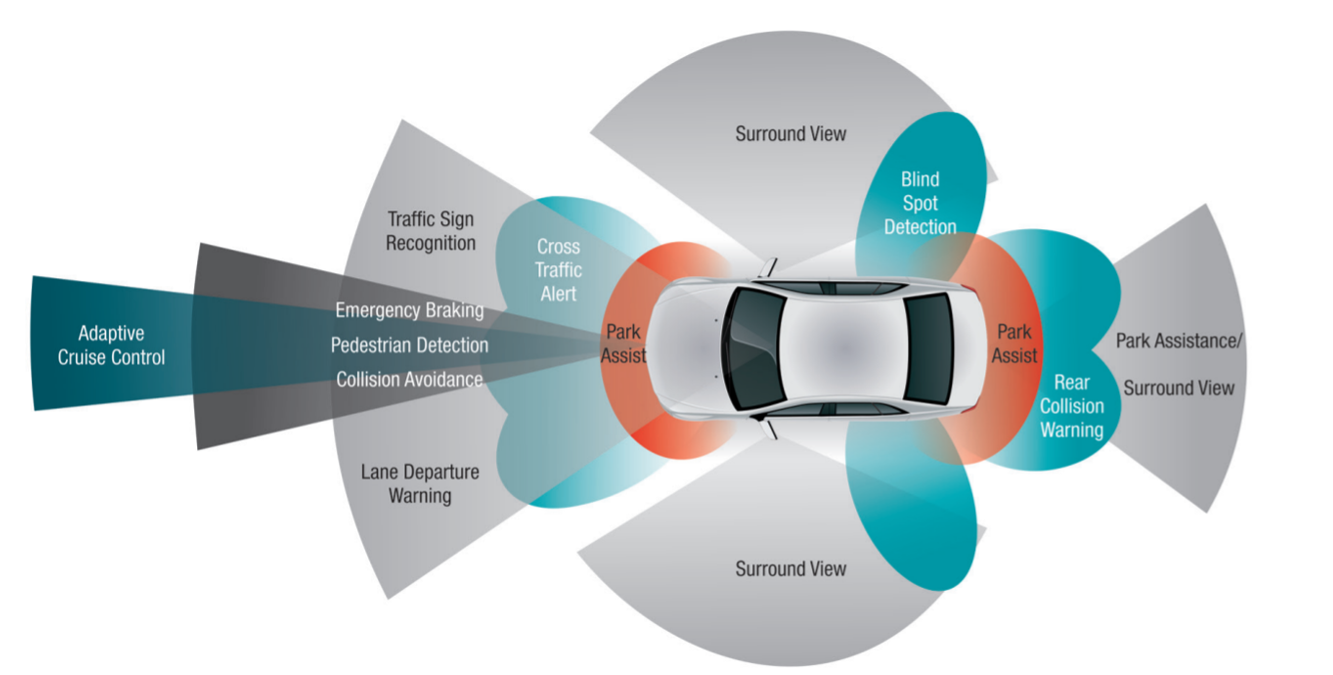 Figure 1-1 Applications for Front, Rear,
and Surround View Cameras in ADAS
Figure 1-1 Applications for Front, Rear,
and Surround View Cameras in ADASSimilar to automotive cameras, industrial camera applications have also experienced dramatic growth and innovation. In the wake of the COVID-19 pandemic, record numbers of people began working and spending more time at home, and many businesses are continuing to address concerns with employees returning back to the office. With more time spent at home, consumer demands for smart security and video doorbell cameras have increased for personal and property safety. On the commercial side, COVID-19 has driven the increased use of touchless devices like internet protocol (IP) network cameras for applications such as facial recognition access control, building occupancy tracking, and object detection to minimize physical contact risk.
 Figure 1-2 Applications for Industrial
Cameras such as Security, Facial Recognition Access, and Automation
Figure 1-2 Applications for Industrial
Cameras such as Security, Facial Recognition Access, and AutomationCameras enable a vehicle or a network system to gather environmental data, which can then be processed and have corrective action taken, often autonomously. Because cameras directly link safety-assisted or autonomous vehicles to their surroundings, the safety of drivers and passengers is extremely dependent on the performance of the camera system. Front and rear cameras must be able to support higher processing power for a fast response time in cross-traffic and collision detection applications. Accurately combining the multiple surround-view camera images is needed to reliably support functions such as adaptive cruise control and blind spot detection. The performance level of these cameras determines how far away the system can detect a potential hazard, how small or hidden the hazard can be before the system detects it, and how fast information can be transmitted to the central electronic control unit (ECU) of the car. One important factor when considering how to achieve high performance levels of driver-assisting cameras is extreme temperatures that can occur in the camera modules themselves. Very hot or cold temperatures are known to negatively impact the image quality and component operation in an application where high error rates cannot be tolerated. Therefore, ensuring reliable camera operation to protect all drivers and passengers is more critical than ever as vehicles are becoming increasingly more dependent on cameras for safety features.
On the industrial camera side, units are more likely to be located in static, outdoor locations where they cannot be shielded from extreme temperature and weather conditions like rain and snow. Because moisture buildup in smart video doorbells or IP cameras can fog the camera lenses, short electrical circuitry, and is often accompanied by high temperatures, the accuracy of the live camera feed and the following actions taken by an automated system heavily depend on camera performance. Both temperature and humidity sensing in industrial cameras focus on reliable camera operation to ensure clear images for security and object identification. Network security camera enclosures can receive IP ratings to identify how protected a camera is from its external environment, including liquids, weather conditions, and corrosion, and temperature or humidity sensing can provide another layer to ensure reliable camera operation.
Temperature sensing is critically important in automotive and industrial cameras for preventing overheating or freezing that can lead to thermal damage, poor performance, and reduced lifetime. The cameras can be exposed to both extremely hot and cold environmental conditions and heat-generating board components, such as Power Management Multichannel ICs (PMICs) or IR LEDs which can have a large impact on the temperature in the camera module itself. This effect of the self-heating feature of the camera is magnified due to the small form-factor of the module. Temperature sensing can be used to alert when the camera gets too hot or cold and activate a cooling or heating element in response to ensure performance and lifetime are not severely damaged. The amount of current going through the camera modules can be reduced to preserve image quality, or thermal compensation in the image sensor can be performed to reduce sensor noise.
Sensor requirements and thermal challenges can vary depending on the type of automotive or industrial camera being designed and what components are present for the temperature sensor to connect to. This application brief is divided into the two sections depending on whether an analog-to-digital converter (ADC) channel is available or not. Common types of cameras seen in both circumstances are also discussed to highlight their unique requirements for temperature sensing.
ADC Channel is not Available
When there are no ADC channels available onboard temperature sensing requirements are slightly different. Applications such as low-end driver monitoring, surround view cameras, video doorbells, and some IP network cameras usually do not have available ADC channels, and instead require a type of digital, remote, or switch temperature sensor. Surround view cameras, also called 360° cameras or camera modules without processing, are current safety options on higher end vehicles that will see significant adoption over the next five to six years. The surround view cameras get their name from being comprised of two to six wide-angle cameras connected to the ECU of the vehicle with at least a 180° horizontal view. Stitching these camera views together provides an image of the surroundings around the entire vehicle, and can assist the driver with typically high-crash functions such as changing lanes and parking. Temperature sensing is needed to ensure the multiple distinct video feeds from different viewpoints are accurately merged to present a unified image.
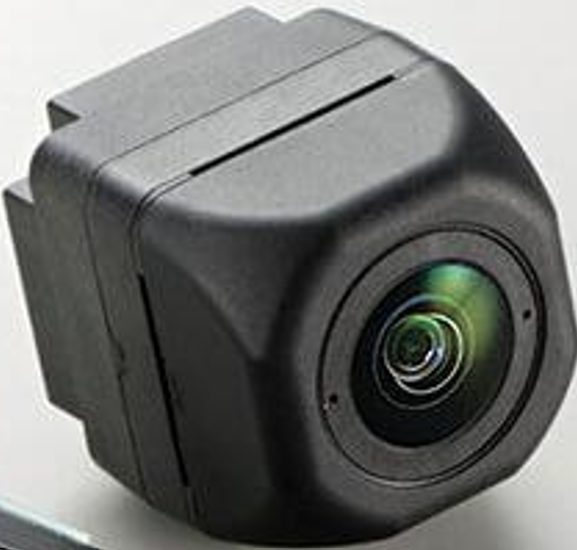 Figure 1-3 Compact Surround View Camera
Module
Figure 1-3 Compact Surround View Camera
ModuleLike surround-view cameras, video doorbells are most often mounted outside and are smaller than front, rear, or IP network cameras. Video doorbells often require higher thermal efficiency due to their small form factor and no air vents, as well as stable battery operation across a wide temperature range, especially negative temperatures. Therefore, normal functionality of the cameras is jeopardized by environmental conditions and the PMIC or board component self-heating within the small camera module.
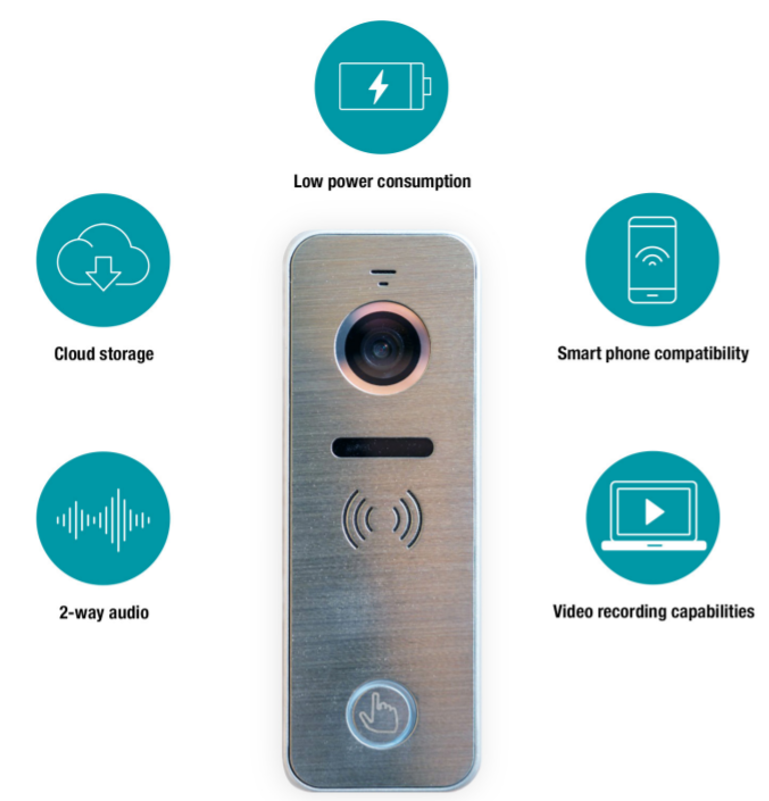 Figure 1-4 Small Form-Factor Video
Doorbell With Highly-Integrated Features
Figure 1-4 Small Form-Factor Video
Doorbell With Highly-Integrated FeaturesMultiple options are available for temperature sensing with no ADC channel in automotive and industrial cameras depending on the system specifications. The first solution could be a digital temperature sensor, which actively monitors temperature and can connect directly to an MCU or a Flat Panel Display Link (FPD-Link) serializer through an I2C or SMBus or SPI. In a vehicle, the serializer can then transmit image data back to the central vehicle ECU or central camera ECU for any necessary correction action to be initiated. The two greatest restraints in selecting the optimal digital temperature sensor for a surround view or video doorbell camera are size and cost. High accuracy and small form-factor options that offer high levels of integration, such as the TMP112(-Q1) and TMP102(-Q1) for I2C interfaces or the TMP126(-Q1) for SPI, can be used to measure both the IR LED or PMIC temperature and the ambient temperature of the camera module. If size is a major system constraint, the TMP103 and TMP114 devices offer active digital temperature monitoring in some of the smallest packages on the market. The TMP103 is the world’s smallest digital temperature sensor with a unique multiple device access mode, which allows communication with multiple TMP103 sensors. The TMP114 is the thinnest digital temperature sensor, allowing the device to be placed underneath heat generating board components, such as the imager, for highly-accurate measurements.
The second type of solution is a remote temperature sensor. These devices utilize a built-in local temperature sensor as well as diode-connected transistors to measure multiple temperatures from varying distances away from the sensor itself. A single-channel device measures one local temperature and one remote temperature, a two-channel device measures one local temperature and two remote temperatures, and so on. Remote temperature sensors are seen in smart video doorbells to measure temperatures in multiple places within the camera module, such as the MCU or the system on chip (SoC), since high temperatures degrade the reliability and performance of the SoC over time. In extreme temperature environments, remote temperature sensors can activate a heating or cooling element to protect internal components from mechanical or electrical failure due to freezing or overheating. There are a variety of options for remote temperature sensing depending on what are the system requirements. Commonly-used remote temperature sensors include the TMP451(-Q1) and TMP461 single-channel devices, the TMP431 two-channel device, and the TMP464 four channel device. Although TMP451(-Q1) and TMP461 are both single-channel remote temperature sensors, the TMP461 features address pins so additional remote temperature sensors can be added to the system in the future, if necessary.
A third solution for many low-cost cameras that do not require active temperature monitoring could be implementing a simple temperature threshold detection with alert and hysteresis as an option for reliable camera operation. In these cases, it is common to use a temperature switch with either one threshold, like the TMP302(-Q1) or two thresholds, like the TMP390(-Q1) for passive temperature monitoring where corrective action can be taken once the component being measured crosses a certain temperature. The TMP302(-Q1) is a factory programmed device, which may offer a smaller size advantage over the TMP390(-Q1), which is resistor programmable. Temperature switches can connect to the MCU or PMIC directly through a general-purpose input/output (GPIO) pin. However, PMIC use can cause temperatures to exceed safe operating limits due to the small form factor of the camera module. Having both an over- and undertemperature alert is often needed in surround view cameras, since they can heat up quickly and be exposed to extreme environmental conditions outside of the vehicle. These alerts can then be used to activate a cooling or heating system to protect the camera components and prevent irreversible damage.
Finally, many camera modules that are mounted outdoors (whether outside a vehicle or building) or use high megapixel (MP) cameras, are sensitive to both extreme temperatures and humidity levels. Humidity sensing could be an important factor to consider in these situations to design systems that can, in case of a moisture leak into the camera module, detect if the camera lens begins fogging or if there is any possible damage to electrical components. Humidity sensors such as the HDC2010 and the HDC3x(-Q1) family provide both accurate temperature and humidity sensing in one integrated device.
ADC Channel is Available
Having an available ADC channel on the board within the camera module itself is seen most often in applications such as high-end driver monitoring, front and rear cameras, and some IP network cameras. Multiple temperature sensors are often needed in front or rear camera systems due to the diverse set of components and safety protocols they contain compared to other types of automotive cameras. Additionally, some advanced “smart” front cameras have added features such as night vision, forward collision warning, and adaptive cruise control that demand higher processing power from the camera board that translates into a faster response time. Being able to send preprocessed data to the central ECU is critical for occupant safety, as it increases the amount of time the vehicle has to take corrective action starting from when the CMOS sensor receives an image.
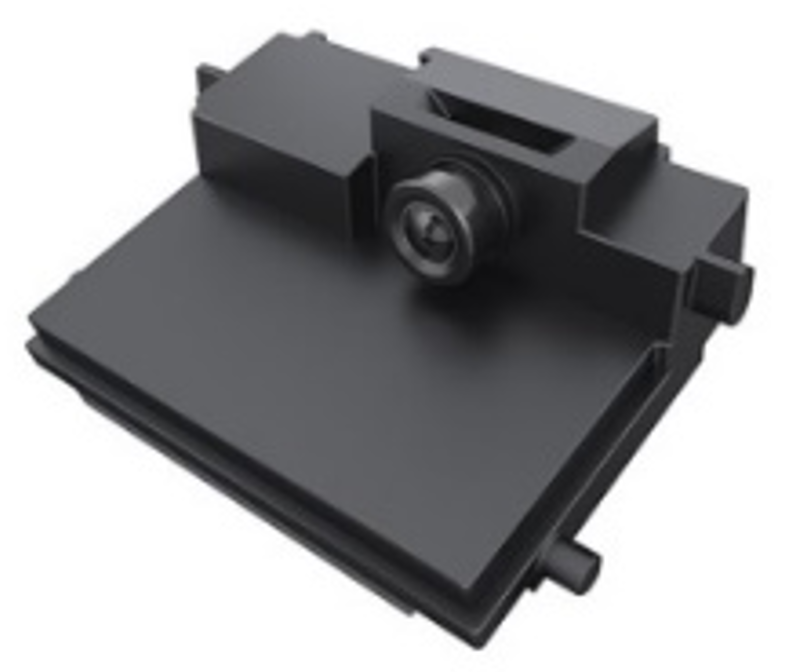 Figure 1-5 Front or Rear Camera Module
With ADC for Onboard Processing
Figure 1-5 Front or Rear Camera Module
With ADC for Onboard ProcessingIn some analog IP cameras, having ADC channels available assists with system reliability if the camera module is in a harsh environment. Onboard processing supports accurate heater or cooler activation, ambient light sensing for dimming, and uniform IR LED illumination.
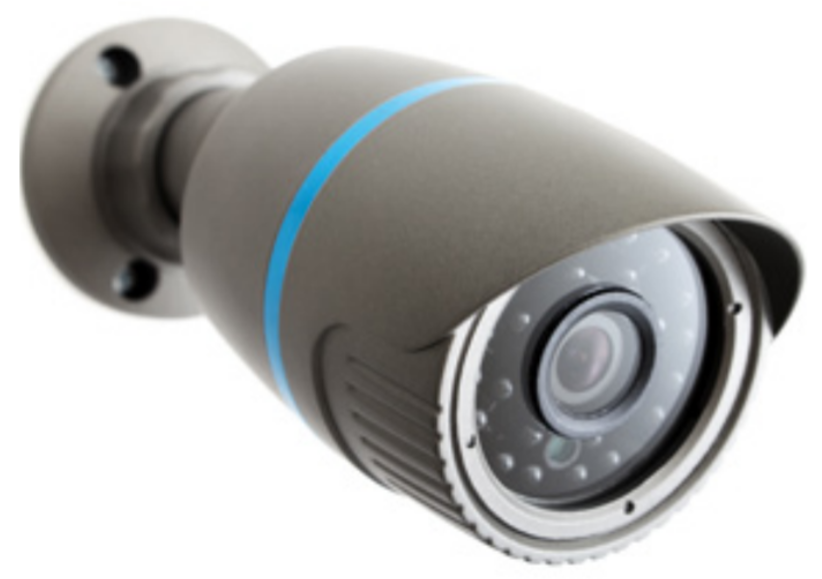 Figure 1-6 IP Network Camera for
Recording, Monitoring, and Automation
Figure 1-6 IP Network Camera for
Recording, Monitoring, and AutomationIR LED failure commonly occurs at high temperatures due to the decrease in output capacity as temperature increases, which could inadvertently put the system into overload failure. In many cases the integrated temperature sensor in the CMOS imager does not have high enough accuracy to prevent thermal damage and reduced image quality. Extremely cold weather can cause camera lenses to contract and crack, potentially leading to moisture leaking into the camera lens. Conversely, extremely hot weather can cause CMOS sensor and battery overheating, leading to image distortion and camera failure. In regions with high humidity, condensation can fog the lenses or damage the electrical components inside the module. Because of the added processing power, the onboard processor is typically the heat-generating element and must be monitored to ensure safe and reliable camera operation.
When ADC channels are available onboard, there are several different options to consider for protecting the reliability and increasing the lifetime of your DMS, front or rear camera, or IP network camera. The ADC converts the analog output of the temperature sensor to a digital form that can be read and processed by a microcontroller unit (MCU). Some MCUs come with built-in ADCs, and other systems use an external ADC on the board; both options can help support greater board processing power. If constant temperature monitoring is desired, TI’s family of linear thermistors, such as the TMP61, are an accurate and low long-term drift option. All of TI’s temperature sensing portfolios also include automotive grade temperature sensors denoted by a -Q1, such as the TMP61-Q1. When higher accuracy is desired, the TMP235(-Q1) is a popular precision analog output temperature sensor that, unlike thermistors, are not discrete and therefore, their voltage drop is not influenced by exterior components. Although high temperature accuracy can be achieved with these external analog temperature sensors, the resolution of the actual temperature value being reported will be limited by the resolution of the ADC.
Additionally, having an ADC channel onboard does not limit your solution to only analog temperature sensors. Any of the temperature or humidity sensing solutions mentioned in the previous section can still be used in a system that has an ADC, it will just not use the ADC channels. In system designs where ADC channels need to be freed up for connections to other components or a smaller sensor is desired to conserve board space, a digital sensor, remote sensor, or temperature switch can still be implemented without the need to connect to the available ADC.
Summary
As innovations in automotive and industrial cameras push the boundaries of image quality, object detection, and more advanced features, high-accuracy temperature monitoring has become crucial for ensuring reliable system operation. Additional safety requirements for ADAS and DMS in autonomous vehicles will also continue to drive temperature sensing in automotive cameras that have little room for error. Integrated temperature sensors within the CMOS image sensor or FPD-Link itself often times cannot reach the worst-case temperature accuracy requirements of many new systems. The type of external temperature sensor selected will vary based on what other onboard components are present (that is, is an ADC channel available) and what accuracy, size, and cost restraints are in your system. The different options highlighted in this article are summarized in Table 1-1, with a sensor denoted with (-Q1) indicating an automotive-grade variation is available.
| Sensor Type | Parameter | Works When ADC Channel is Available | |
|---|---|---|---|
| – | Works When ADC Channel is Not Available | ||
| Temperature | Lower cost | TMP61(-Q1) | TMP102(-Q1) for I2C, TMP126N for SPI |
| Smaller size | TMP61(-Q1) | TMP103 and TMP114N for I2C | |
| Higher accuracy | TMP235(-Q1) | TMP112(-Q1) for I2C, TMP126-Q1 for SPI | |
| Remote sensing | – | TMP431, TMP451(-Q1), TMP461, TMP464 | |
| Temperature switch | – | ||
| Humidity | – | HDC2010, HDC3020(-Q1) | |